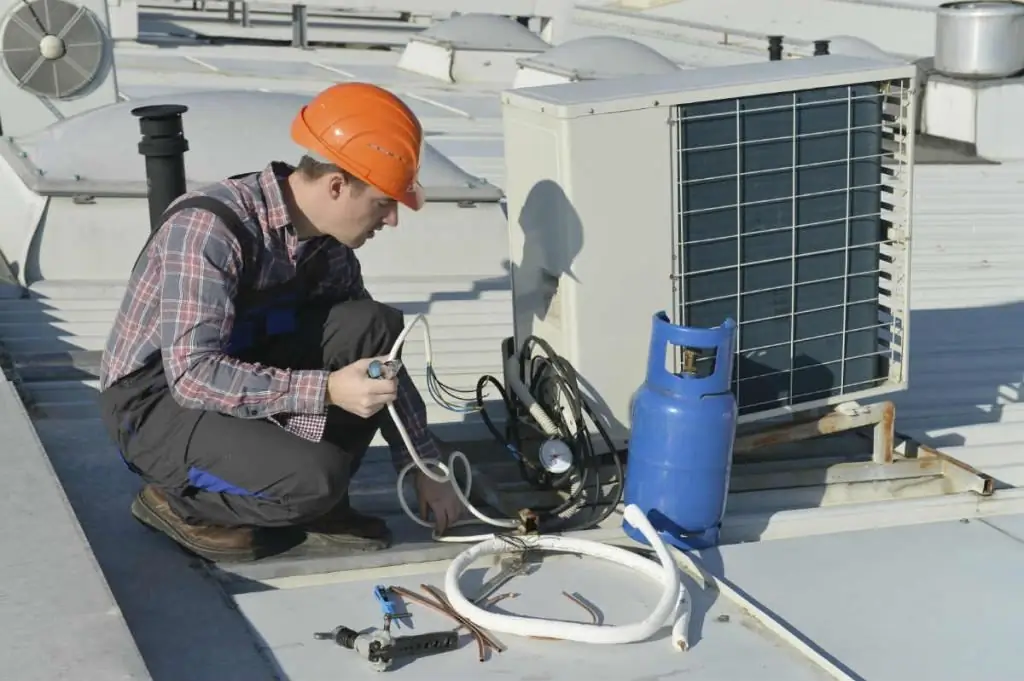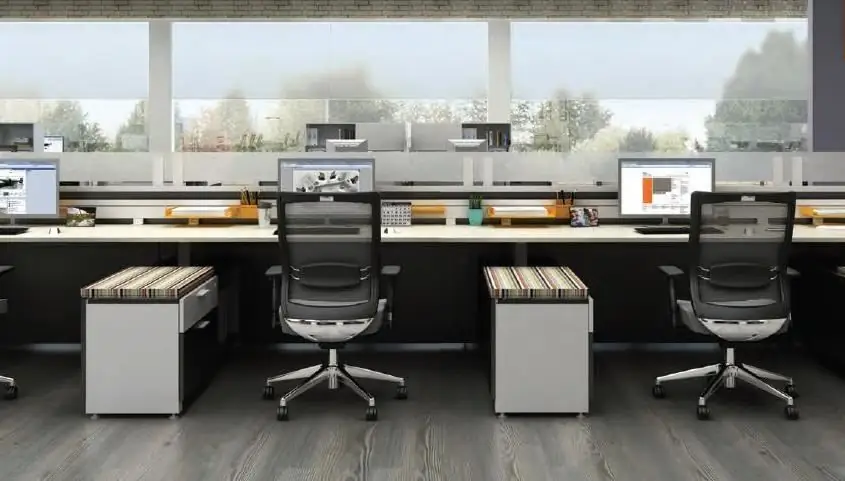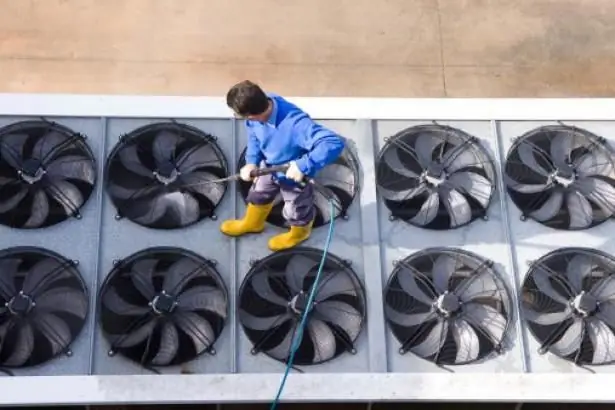2026 Author: Howard Calhoun | [email protected]. Last modified: 2025-01-24 13:10:41
Maintenance of ventilation and air conditioning systems is carried out by persons and organizations that have a special license. This activity requires certain knowledge and skills.

In accordance with the law, entities enter into a contract for the maintenance of ventilation systems. This document specifies all the work, as well as the deadlines for their implementation. In addition, there is a standard regulation for the maintenance of ventilation systems. It establishes the general rules for the execution of work.
License
It is necessary for all entities involved in the maintenance of ventilation and air conditioning systems. The corresponding requirement is provided for by the federal law regulating the licensing of certain types of activities (99-FZ).
To obtain a permit for the maintenance of ventilation and air conditioning systems, it is necessary to submit copies certified by a notary to the authorized body:
- Charter.
- Memorandum.
- Evidence of TIN, OGRN, on amendments to the Unified State Register of Legal Entities.
- Certificates on obtaining the OKVED code (issued by the State Statistics Committee).
- On changes in the statutory documents, decisions on the appointment of a head, the creation of an organization.
- Lease agreements (title deeds) for the premises.
- Paperwork confirming the necessary education of specialists and the CEO.
- Identification documents for specialists and CEO.
The following papers are attached:
- A notarized extract from the state register. However, it must be received no more than 14 days in advance.
- Settlement accounts.
A package of documents is submitted to the licensing authority at the place of business. 30-45 days are allotted for consideration. Having received a license, the company can carry out maintenance of ventilation and air conditioning systems in any region of the Russian Federation.

Agreement
It is concluded by the customer and the person who will carry out maintenance of ventilation systems. The standard contract should contain the following items:
- Subject of the agreement.
- Responsibilities of participants.
- Cost of work, estimated estimate.
- The order of acceptance and delivery of work performed.
- Responsibility of participants.
- Dispute Resolution Policy.
- Additional/final provisions.
- Details of the parties.
BThe contract must contain references to annexes. They define a specific list of maintenance work for ventilation systems. Their frequency and duration are also set here.
The agreement must also be accompanied by a protocol for agreeing on the cost of maintenance of the supply and exhaust ventilation system.
Features of the regulations
This document defines the frequency of maintenance work for each individual module included in the system:
- Fans.
- Calorifers.
- Filters.
- Damper.
- Electrical.
- Controllers.
The regulations provide for service work, the list of which is determined by the system manufacturer and depends on the purpose of the equipment.
Typically maintenance of the ventilation system is done quarterly.

Checking equipment performance
It is carried out together with the current repairs. During the check, an aerodynamic test is carried out, during which:
- Performance of general exchange, emergency, backup ventilation.
- Total pressure supplied by fans.
- Pressure rate at startup.
- Amount of air flow passing through the main sections and branches.
- Pressure differences between the system chamber and adjacent rooms.
- No air leaks or suction.
- Multiplicityair exchange.
After verification, the obtained data are compared with the design data, malfunctions and defects of the system are identified, and the necessary amount of work is planned.
Chambers and shafts
During the maintenance of the exhaust ventilation system, a check is carried out:
- Density of connection of transitions to the chamber from the fan, condition of sections of passage through the roof.
- States of nets, filters, umbrellas, louvres over mines. They are cleaned if necessary.
- Tightness of shaft structures, sound and heat insulation.
- Bolt fasteners.
- Support structures for dents, corrosion, holes. The color quality is also checked.
Maintenance and repair of the ventilation system also includes:
- Tightening of bolted connections, including replacement of fasteners in the presence of defects.
- Replacement of faulty nets, filters, louvres.
- Restoration (reapplying) of anti-corrosion coating.

Fans
During the maintenance of supply ventilation systems, a check is made:
- The tightness of the sections, the condition of the casing, the connections of its elements.
- Conditions of couplings, pulleys, shafts, belt drive, lack of extraneous noise, bearing temperature, pulley fit on the shaft, suction.
- Coaxiality of drives, parameters of mutual arrangement of the fanand electric motor (when belt drive), horizontal fan level.
- Conditions of vibration bases, soft inserts, grounding, as well as frame integrity.
In addition, the following are performed:
- Vibration measurements on foundation bolts and bearings of ventilation units.
- Short-term start of redundant and infrequently used fans.
- Tightening of fasteners, correction of defects in seams and dents in the casing (replacement if necessary).
- Replacing paddles.
- Belt replacement.
- Welding cracks on the impeller.
Maintenance of the smoke extraction and smoke ventilation system
In the process of maintenance, the following types of work are carried out:
- Checking tightness of fasteners with bolt tightening.
- Detection of holes, corrosion, dents.
- Check fasteners (clamps, brackets, hangers).
- Evaluation of the performance of fire dampers, gates, other control and locking devices.
- Visual inspection of the technical condition of fire-retarding and check valves for cracks and other defects.
- Checking the damper position.
- Checking the fixation of the valves to the duct.
- Assessing the operation of exhaust and intake devices.

As part of the ongoing repairs, among other things, the following are carried out:
- Checking the operation of the shutters, troubleshooting.
- Recoverylattices and grids.
- Correction of dents, curvature.
- Replacement of worn-out elements.
- Troubleshooting control and locking devices.
- Regulation of the position of local suctions installed in places accessible without disassembly.
- Replacement of heat, fire insulation.
- Repair of fire retardant and anti-corrosion coatings.
Deflectors and heaters
Maintenance for these devices includes:
- Checking the condition of the deflector fixation points.
- Check damper control.
- Checking the absence of leaks in heaters.
- Evaluation of the effectiveness of maintaining the temperature level.
If necessary, the heating tubes are sealed (in case of depressurization).
Automatic
Inspection and repair of equipment is carried out in accordance with the maintenance schedule for ventilation systems approved by the enterprise.
In the course of work, the efficiency of the system is evaluated with the verification of the correctness of the indicators of the specified modes (winter / summer). If necessary, the necessary parameters are set in accordance with the mode. The specified indicators are entered in the certificate of completion.
All detected malfunctions are subject to elimination.

Electric motors
During maintenance:
- Inspection and repair of identified visible damage.
- Examination of the condition of the cableinput, housing elements, seals.
- Short-term start or scrolling of the rotor during a break in operation for more than 3 months.
Additionally checked:
- Insulators, ground conductor.
- Ground loop, guardrail, frame attachment.
- Control, ventilation, cooling, protection systems.
Dirty channels are cleaned; the inscriptions on the casing are restored.
As part of the ongoing repairs are:
- Disassembly of equipment as needed.
- Purge of the rotor, stator with compressed air.
- Checking and measuring the gap between the bearing cover and the bushing.
- Evaluation of insulation resistance and other parameters.
- Checking the condition of the elements in the cooling system.
- Inspection of launchers.
- Assessment of functioning by vibroacoustic and temperature indicators.
- Inspection, replacement, dismantling of the coupling half.
- Equipment assembly and testing.
Control systems
They include shields, consoles, junction boxes. Maintenance work includes:
- Inspection and detection of damage, dirt, corrosion, checking the reliability of fasteners.
- Cleaning of dirt and dust from outdoor elements.
- Checking the legibility of the inscriptions, the reliability of the fastening of the plates.
- Inspection of seals, cables, grounding, casings.
- Checking the reliability of fastening parts, contact connections, serviceability of locks.
Without failimplemented:
- Checking the attachment of cases to walls and other surfaces.
- Reliability of tightening parts and contact connections. If necessary, the contacts are cleaned.
- Checking the condition of the insulation of cables, wires.
- Partial disassembly to detect defects.
- Checking the operation of protective devices.
- Restoration of inscriptions, insulating coating, painting.
- Checking the suitability of devices for loads and operating conditions.
- Cleaning of external parts, lubrication of constantly rubbing elements.
- Identification of defective parts and assemblies.
- Checking the tightness of the contact contacts and the simultaneity of turning on their respective groups.
- Check signal lamps, replace them, repair fittings.

Electric heaters
Device service involves:
- Inspection and identification of external damage.
- Assessing the condition of switches, thermostat, regulators.
- Checking the correct operation of the residual current circuit breaker and adjusting devices.
- Cleaning of external elements from dirt and dust.
In addition, checks are in progress:
- Actual loads on connections.
- Cables, housings, glands, grounding for damage.
- Reliability of fasteners.
- Fuses.
- Status of circuit breakers.
- Protective device settings.
- Resistance of heating parts and insulation of lead wires.
Off-season regulations
They provide for technical measures aimed at preparing the ventilation system for launch or conservation. The first ones are produced before putting the equipment into operation after the winter break. Maintenance of ventilation systems in preparation for the summer season is carried out in the spring. During it, specialists perform the following work:
- Opening valves.
- Draining antifreeze from the system (if it was filled).
- Filling the hydraulic system with water.
- Air outlet.
- Preparing the system for automatic start-up remotely at the signal of the operator (dispatcher) or when a certain air temperature is reached.
Before the beginning of the winter period, the system is being preserved. All works included in the quarterly list are preliminarily performed. After that:
- Stop valve closes.
- Water (refrigerant) drains from the system.
- Residual water is removed from the cooler. This is done by blowing air and drying.
If the last step is not possible, the cooler is filled with antifreeze, the remaining air is removed.
Recommended:
Air conditioning system maintenance: choosing a company, concluding a contract, rules for registration, act of work performed, maintenance instructions, regulations and safe work

The main task of the ventilation system is to provide access and exhaust air, as well as its filtration and temperature control. In order for these tasks to be fully completed, it is necessary to install special equipment, as well as equip the blower system. Maintenance of the air conditioning and ventilation system is mandatory for both civil and industrial facilities
Workplace maintenance: organization and maintenance of the workplace

An important part of the process of organizing labor in production is the organization of the workplace. Performance depends on the correctness of this process. An employee of the company should not be distracted in his activities from the fulfillment of the tasks assigned to him. To do this, it is necessary to pay due attention to the organization of his workplace. This will be discussed further
Visa and Mastercard systems in Russia. Description of Visa and Mastercard payment systems

Payment system - a commonality of methods and tools used for money transfers, settlements and regulation of debt obligations between participants in economic turnover. In many countries, they differ significantly from each other due to the diverse provisions in the levels of economic development and the characteristics of banking legislation
Aerodynamic testing of ventilation systems. Aerodynamic test methods

Aerodynamic tests are carried out by accredited laboratories in accordance with standards and sanitary norms. Why and how ventilation systems are checked, methods of aerodynamic tests in general terms and documentation that is drawn up based on the results of tests - general contractors, customers for the construction of residential and public buildings, specialists from management companies and heads of engineering services of industrial enterprises need to know at least in order to understand which document
Air conditioning and ventilation, air heating

For the normal existence and life of a person, it is necessary to create and maintain certain parameters of the environment, including air. Changes in temperature, the accumulation of harmful impurities in it significantly affect the well-being of people and their he alth. To maintain the desired characteristics of the air in the room, special equipment is used

